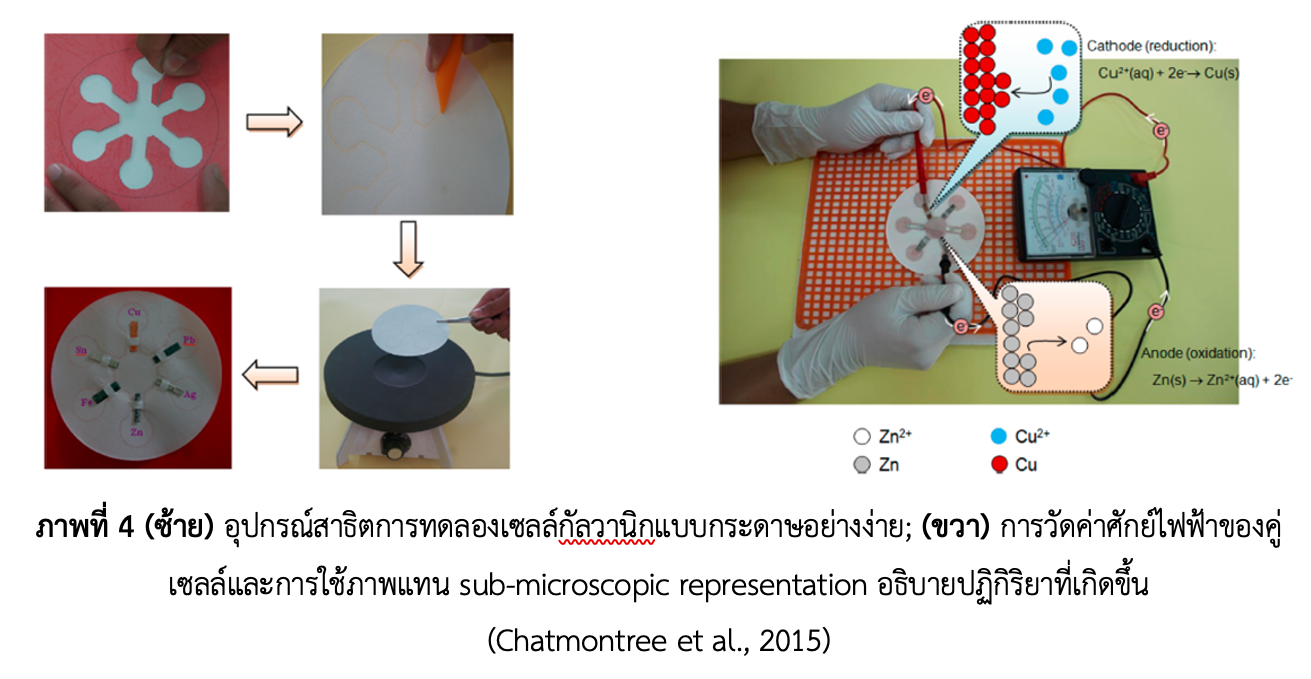การทบทวนการพัฒนาอุปกรณ์แบบกระดาษและเส้นด้ายอย่างง่ายสำหรับห้องเรียนเคมี
Main Article Content
บทคัดย่อ
บทความนี้ได้รวบรวมงานวิจัยที่เกี่ยวข้องกับการพัฒนาอุปกรณ์วิเคราะห์แบบกระดาษและเส้นด้ายอย่างง่ายสำหรับห้องเรียนเคมีที่ทำให้ผู้เรียนเห็นภาพและเรียนรู้ได้ง่าย งานวิจัยที่ใช้อุปกรณ์วิเคราะห์แบบกระดาษและเส้นด้ายเน้นการพัฒนาอุปกรณ์ตรวจวิเคราะห์เพื่อเป็นทางเลือกเพิ่มเติมจากการวิเคราะห์ในระบบของเหลวที่ใช้เครื่องมือที่มีราคาแพง ปัจจุบันนักวิจัยได้พัฒนาอุปกรณ์แบบกระดาษและเส้นด้ายอย่างง่ายสำหรับการวิเคราะห์ที่หลากหลาย เช่น การวัดอัตราการเกิดปฏิกิริยาเคมี การทดสอบด้วยการวัดค่าทางสี การวินิจฉัยสุขภาพ การตรวจสอบด้านสิ่งแวดล้อมและการทดสอบคุณภาพอาหาร เหตุผลที่กระดาษและเส้นด้ายเป็นวัสดุที่น่าสนใจสำหรับการผลิตระบบไมโครฟลูอิดิกส์หรือของไหลจุลภาค ได้แก่ (1) เป็นวัสดุเซลลูโลสที่มีราคาถูกและหาได้ง่าย (2) เข้ากันได้กับสารเคมีทางชีวเคมีและการแพทย์ และ (3) สามารถขนส่งของเหลวด้วยแรงแคปิลลารีโดยไม่ต้องอาศัยแรงภายนอก โดยการสร้างช่องไมโครฟลูอิดิกส์บนกระดาษด้วยรูปแบบต่างๆ จะทำให้การไหลของของเหลวบนกระดาษถูกจำกัดอยู่ภายในช่องที่กำหนด ดังนั้น การไหลของของเหลวจึงสามารถถูกนำทางในลักษณะที่ควบคุมได้ การวิจัยเกี่ยวกับไมโครฟลูอิดิกส์แบบกระดาษกำลังเป็นที่นิยม ผลงานที่เผยแพร่ส่วนใหญ่ได้เน้นไปที่ (1) การประดิษฐ์อุปกรณ์ไมโครฟลูอิดิกที่ใช้กระดาษต้นทุนต่ำและใช้เทคนิคที่เรียบง่าย และ (2) การใช้งานอุปกรณ์ไมโครฟลูอิดิกส์แบบกระดาษโดยผสมผสานวิธีการตรวจจับแบบใหม่ๆ เช่น การวิเคราะห์ภาพถ่ายจากกล้องสามาร์ทโฟนด้วยซอฟต์แวร์วิเคราะห์สีที่มีประสิทธิภาพและรู้ผลได้ไว โดยบทความนี้ได้ทบทวนทั้งเทคนิคการประดิษฐ์และการประยุกต์ใช้ไมโครฟลูอิดิกส์แบบกระดาษและเส้นด้ายด้วยการทดลองที่หลากหลาย แต่คำนึงถึงประสิทธิภาพในการตรวจวัดและสามารถนำมาประยุกต์ใช้ในการเรียนรู้ โดยได้รวบรวมทั้งด้านจุดเด่นและจุดควรปรับปรุงของงานวิจัยที่เผยแพร่ตั้งแต่ปี พ .ศ. 2550 จนถึงปัจจุบัน
Article Details

อนุญาตภายใต้เงื่อนไข Creative Commons Attribution-NonCommercial-NoDerivatives 4.0 International License.
วารสารวิทยาศาสตร์และวิทยาศาสตร์ศึกษา (JSSE) เป็นผู้ถือลิสิทธิ์บทความทุกบทความที่เผยแพร่ใน JSSE นี้ ทั้งนี้ ผู้เขียนจะต้องส่งแบบโอนลิขสิทธิ์บทความฉบับที่มีรายมือชื่อของผู้เขียนหลักหรือผู้ที่ได้รับมอบอำนาจแทนผู้เขียนทุกนให้กับ JSSE ก่อนที่บทความจะมีการเผยแพร่ผ่านเว็บไซต์ของวารสาร
แบบโอนลิขสิทธิ์บทความ (Copyright Transfer Form)
ทางวารสาร JSSE ได้กำหนดให้มีการกรอกแบบโอนลิขสิทธิ์บทความให้ครบถ้วนและส่งมายังกองบรรณาธิการในข้อมูลเสริม (supplementary data) พร้อมกับนิพนธ์ต้นฉบับ (manuscript) ที่ส่งมาขอรับการตีพิมพ์ ทั้งนี้ ผู้เขียนหลัก (corresponding authors) หรือผู้รับมอบอำนาจ (ในฐานะตัวแทนของผู้เขียนทุกคน) สามารถดำเนินการโอนลิขสิทธิ์บทความแทนผู้เขียนทั้งหมดได้ ซึ่งสามารถอัพโหลดไฟล์บทความต้นฉบับ (Manuscript) และไฟล์แบบโอนลิขสิทธิ์บทความ (Copyright Transfer Form) ในเมนู “Upload Submission” ดังนี้
1. อัพโหลดไฟล์บทความต้นฉบับ (Manuscript) ในเมนูย่อย Article Component > Article Text
2. อัพโหลดไฟล์แบบโอนลิขสิทธิ์บทความ (Copyright Transfer Form) ในเมนูย่อย Article Component > Other
ดาวน์โหลด ไฟล์แบบโอนลิขสิทธิ์บทความ (Copyright Transfer Form)
เอกสารอ้างอิง
Agustini, D., Bergamini, M. F., and Marcolino-Junior, L. H. (2018). Simple and inexpensive microfluidic thread based device for teaching microflow injection analysis and electrochemistry. Journal of Chemical Education, 95(8), 1411-1414.
Bruzewicz, D. A., Reches, M., & Whitesides, G. M. (2008). Low-cost printing of poly (dimethylsiloxane) barriers to define microchannels in paper. Analytical chemistry, 80(9), 3387-3392.
Cai, L., Wu, Y., Xu, C., and Chen, Z. (2012). A simple paper-based microfluidic device for the determination of the total amino acid content in a tea leaf extract. Journal of Chemical Education, 90(2), 232-234.
Cai, L., Zhang, X., Luo, L., Lin, H., Chen, J., Xu, C., Zhong, M., and Liao, X. (2019). Visual quantification of Fe on cotton thread using a ruler. Journal of Chemical Education, 96(7), 1532-1535.
Chatmontree, A., Chairam, S., Supasorn, S., Amatatongchai, M., Jarujamrus, P., Tamuang, S., and Somsook, E. (2015). Student fabrication and use of simple, low-cost, paper-based galvanic cells to investigate electrochemistry. Journal of Chemical Education, 92(6), 1044-1048.
ImageJ software. (2021) https://imagej.nih.gov/ij/ (accessed Nov. 2021).
Kajornklin, P., Jarujamrus, P., Phanphon, P., Ngernpradab, P., Supasorn, S., Chairam, S., Amatatongchai, M. (2020). Fabricating a low-cost, simple, screen-printed paper towel-based experimental device to demonstrate the factors affecting chemical equilibrium and chemical equilibrium constant, Kc. Journal of Chemical Education, 97(7), 1984–1991.
Lai, H., Li, Z., Zhu, S., Cai, L., Xu, C., and Zhou, Q. (2020). Naked-Eye detection of aluminum in gastric drugs on a paper-based analytical device. Journal of Chemical Education, 97(1), 295−299.
Mahadeva, S. K., Walus, K., and Stoeber, B. (2015). Paper as a platform for sensing applications and other devices: a review. ACS Applied Materials and Interfaces , 7(16), 8345-8362.
Martinez, A. W., Phillips, S. T., Butte, M. J., and Whitesides, G. M. (2007). Patterned paper as a platform for inexpensive, low-volume, portable bioassays. Angewandte Chemie International Edition, 46(8), 1318-20.
Namwong, P., Jarujamrus, P., Amatatongchai, M., and Chairam, S. (2018). Fabricating simple wax screen-printing paper-based analytical devices to demonstrate the concept of limiting reagent in acid–base reactions. Journal of Chemical Education, 95(2), 305-309.
Naksen, P, Saisui, P., Chomphu, T., Chaksuma, W., Anutrasakda, W. and Jarujamrus, P. (2021). Barcode-like paper sensor for water hardness detection. Journal of Science and Science Education, 4(1), 51-61.
Nilghaz, A., Liu, X., Ma, L., Huang, Q., and Lu, X. (2019). Development of fabric-based microfluidic devices by wax printing. Cellulose, 26(5), 3589-3599.
Prabpal, J., Vilaivan, T., and Praneenararat, T. (2017) Paper-based heavy metal sensors from the concise synthesis of an anionic porphyrin: a practical application of organic synthesis to environmental chemistry. Journal of Chemical Education, 94(8), 1137−1142.
Ravgiala, R. R., Weisburd, S., Sleeper, R., Martinez, A., Rozkiewicz, D., Whitesides, G. M., Hollar, K. A. (2014). Using Paper-based diagnostics with high school students to model forensic investigation and colorimetric analysis. Journal of Chemical Education, 91(1), 107-111.
Reches, M., Mirica, K. A., Dasgupta, R., Dickey. M. D., Butte, M. J. and Whitesides, G. M. (2010). Thread as a matrix for biomedical assays. ACS Applied Materials & Interfaces, 2, (6) 1722-1728.
Sameenoi, Y., Nongkai, P. N., Nouanthavong, S., Henry, C. S., and Nacapricha, D. (2014). One-step polymer screen-printing for microfluidic paper-based analytical device (PAD) fabrication. Analyst, 139(24), 6580-6588.
Xu, C., Cai, L., Zhong, M., and Zheng, S. (2015). Low-cost and rapid prototyping of microfluidic paper-based analytical devices by inkjet printing of permanent marker ink. RSC Advances, 5(7), 4770-4773.
Xu, C., Lin, W., Cai, L. (2016). Demonstrating electrophoretic separation in a straight paper channel delimited by a hydrophobic wax barrier. Journal of Chemical Education, 93(5), 903-905.
Xu, C., Jiang, D., Lin, J., and Cai, L. (2018). Cross channel thread-based microfluidic device for separation of food dyes. Journal of Chemical Education, 95(6), 1000-1003.
Zhang, Y., Zhou, C., Nie, J., Le, S., Qin, Q., Liu, F., Li, Y., and Li, J. (2014). Equipment-free quantitative measurement for microfluidic paper-based analytical devices fabricated using the principles of movable-type printing. Analytical chemistry, 86(4), 2005-2012.
Wang, B., Lin, Z., and Wang, M. (2015). Fabrication of a paper-based microfluidic device to readily determine nitrite ion concentration by simple colorimetric assay. Journal of Chemical Education, 92(4), 733-736.


